This is a review project by "Takeru," a CROWD ROASTER user who has been using the service since its early days and has worked in the coffee industry for a long time.
This time, we will be reviewing " SL28 Kenya Kiamabara Coffee Factory Washed" roasted by two people, Yoshiyuki Nakamura of mamepolepole and Tomomichi Morifuji of RED POISON COFFEE ROASTERS, comparing the two!
This time, we will be reviewing " SL28 Kenya Kiamabara Coffee Factory Washed" roasted by two people, Yoshiyuki Nakamura of mamepolepole and Tomomichi Morifuji of RED POISON COFFEE ROASTERS, comparing the two!
Kenyan Washed Taste Comparison
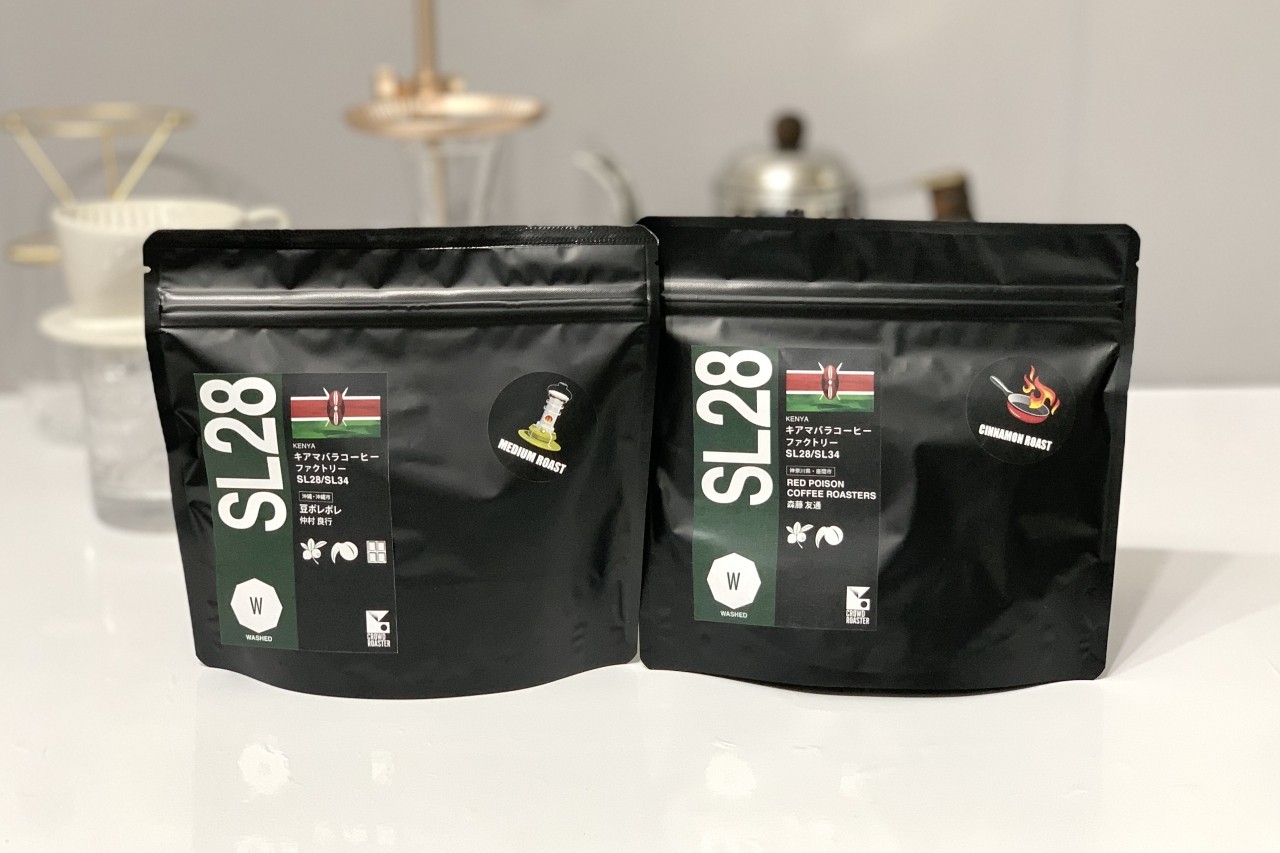
Hello everyone.
I'm Takeru, a CROWD ROASTER user.
This time, we tried comparing the taste of " SL28 Kenya Kiamavala Coffee Factory Washed" coffee roasted by two roasters.
This [ SL28 ] was distributed as sample green beans at CROWD ROASTER booth at last year's specialty coffee festival, SCAJ 2022, so many people may have tried it.
That's where I first tried this brand.
To be honest, I didn't have high expectations for this product before I tried it.
However, when I tried it, I found that it not only had the wild, distinctive taste that is typical of Kenya, but also had a delicate and complex flavor.It was interesting to see the differences in how the roasters finished it, and I have come to like it so much that I have asked four or five roasters to roast it for me.
The "Kiamavala Coffee Factory" in the name of this brand is the name of the "refinery," where the seeds are removed from the "coffee cherries" in fruit form, dried, and turned into "green beans."
The Mugaga Agricultural Cooperative runs this sorting facility, and small-scale farmers in the neighborhood bring the cherries they grow near their homes there for processing.
By the way, the process of turning coffee cherries into green beans is called the "selection method," "refining method," "production processing," "process," etc. in Japan.
It's probably easy to imagine the production processing and life cycle, but words like "selection" and "refining" are not very familiar to most people outside of coffee.
Let's look up the meaning,
Selection: To select the best from many. Selection.
Refining: Removing impurities and producing something pure and good.
*From "Digital Daijisen"
It says:
Recently, with the popularity of anaerobic fermentation and other processes, many people think that this process is about "creating the flavor of the coffee," and while that is of course correct, it is also an important process of "selecting" good coffee beans.
The steps in the washed process used in this SL28 can be broken down as follows:
1. First, the fruit is harvested (depending on the grade, only fully ripe fruit is hand-picked).
2. (Depending on the farm and grade) Harvested fruit is visually selected
3. Float them on water to determine ripeness (ripe and heavy ones will sink, light ones will float)
4. The process of removing the cherries (pulp) is called pulping.
5. To remove the mucilage that surrounds the seeds, they are soaked in water and allowed to decompose with microorganisms (or the seeds can be removed by rubbing them together mechanically).
6. Wash the parchment coffee (shelled seeds) thoroughly with water.
7. Dry in a dryer or in the sun
8. Curing is a process in which raw beans are stored in a constant temperature and humidity environment for around two months to rest.
9. The shell around the seed, called parchment, is removed.
10. Sorting by screen size (bean size)
11. Density (specific gravity) sorting
12. Mechanical sorting
13. Hand-selection (depending on the grade purchased)
It goes through several steps like the ones above.
As you can see, "sorting" takes place in about half of the process.
While most people focus on the process up to drying, the latter process, which focuses on sorting, is also included in the process of "selection" or "refining," so I think the words "selecting the better products" fit well.
Returning to the main topic, in Kenya, there is sometimes a slightly unusual step that is added between the usual washed process described above.
This method is called "soaking."
After soaking the mucilage in water to break it down in step "5" above, you then soak it again in "clean water" overnight.
It is believed that this process brings out the clean acidity that is characteristic of Kenya and leads to a clean cup.
Well, that was a long introduction, but let's start by looking at each bean side.
I'm Takeru, a CROWD ROASTER user.
This time, we tried comparing the taste of " SL28 Kenya Kiamavala Coffee Factory Washed" coffee roasted by two roasters.
This [ SL28 ] was distributed as sample green beans at CROWD ROASTER booth at last year's specialty coffee festival, SCAJ 2022, so many people may have tried it.
That's where I first tried this brand.
To be honest, I didn't have high expectations for this product before I tried it.
However, when I tried it, I found that it not only had the wild, distinctive taste that is typical of Kenya, but also had a delicate and complex flavor.It was interesting to see the differences in how the roasters finished it, and I have come to like it so much that I have asked four or five roasters to roast it for me.
The "Kiamavala Coffee Factory" in the name of this brand is the name of the "refinery," where the seeds are removed from the "coffee cherries" in fruit form, dried, and turned into "green beans."
The Mugaga Agricultural Cooperative runs this sorting facility, and small-scale farmers in the neighborhood bring the cherries they grow near their homes there for processing.
By the way, the process of turning coffee cherries into green beans is called the "selection method," "refining method," "production processing," "process," etc. in Japan.
It's probably easy to imagine the production processing and life cycle, but words like "selection" and "refining" are not very familiar to most people outside of coffee.
Let's look up the meaning,
Selection: To select the best from many. Selection.
Refining: Removing impurities and producing something pure and good.
*From "Digital Daijisen"
It says:
Recently, with the popularity of anaerobic fermentation and other processes, many people think that this process is about "creating the flavor of the coffee," and while that is of course correct, it is also an important process of "selecting" good coffee beans.
The steps in the washed process used in this SL28 can be broken down as follows:
1. First, the fruit is harvested (depending on the grade, only fully ripe fruit is hand-picked).
2. (Depending on the farm and grade) Harvested fruit is visually selected
3. Float them on water to determine ripeness (ripe and heavy ones will sink, light ones will float)
4. The process of removing the cherries (pulp) is called pulping.
5. To remove the mucilage that surrounds the seeds, they are soaked in water and allowed to decompose with microorganisms (or the seeds can be removed by rubbing them together mechanically).
6. Wash the parchment coffee (shelled seeds) thoroughly with water.
7. Dry in a dryer or in the sun
8. Curing is a process in which raw beans are stored in a constant temperature and humidity environment for around two months to rest.
9. The shell around the seed, called parchment, is removed.
10. Sorting by screen size (bean size)
11. Density (specific gravity) sorting
12. Mechanical sorting
13. Hand-selection (depending on the grade purchased)
It goes through several steps like the ones above.
As you can see, "sorting" takes place in about half of the process.
While most people focus on the process up to drying, the latter process, which focuses on sorting, is also included in the process of "selection" or "refining," so I think the words "selecting the better products" fit well.
Returning to the main topic, in Kenya, there is sometimes a slightly unusual step that is added between the usual washed process described above.
This method is called "soaking."
After soaking the mucilage in water to break it down in step "5" above, you then soak it again in "clean water" overnight.
It is believed that this process brings out the clean acidity that is characteristic of Kenya and leads to a clean cup.
Well, that was a long introduction, but let's start by looking at each bean side.
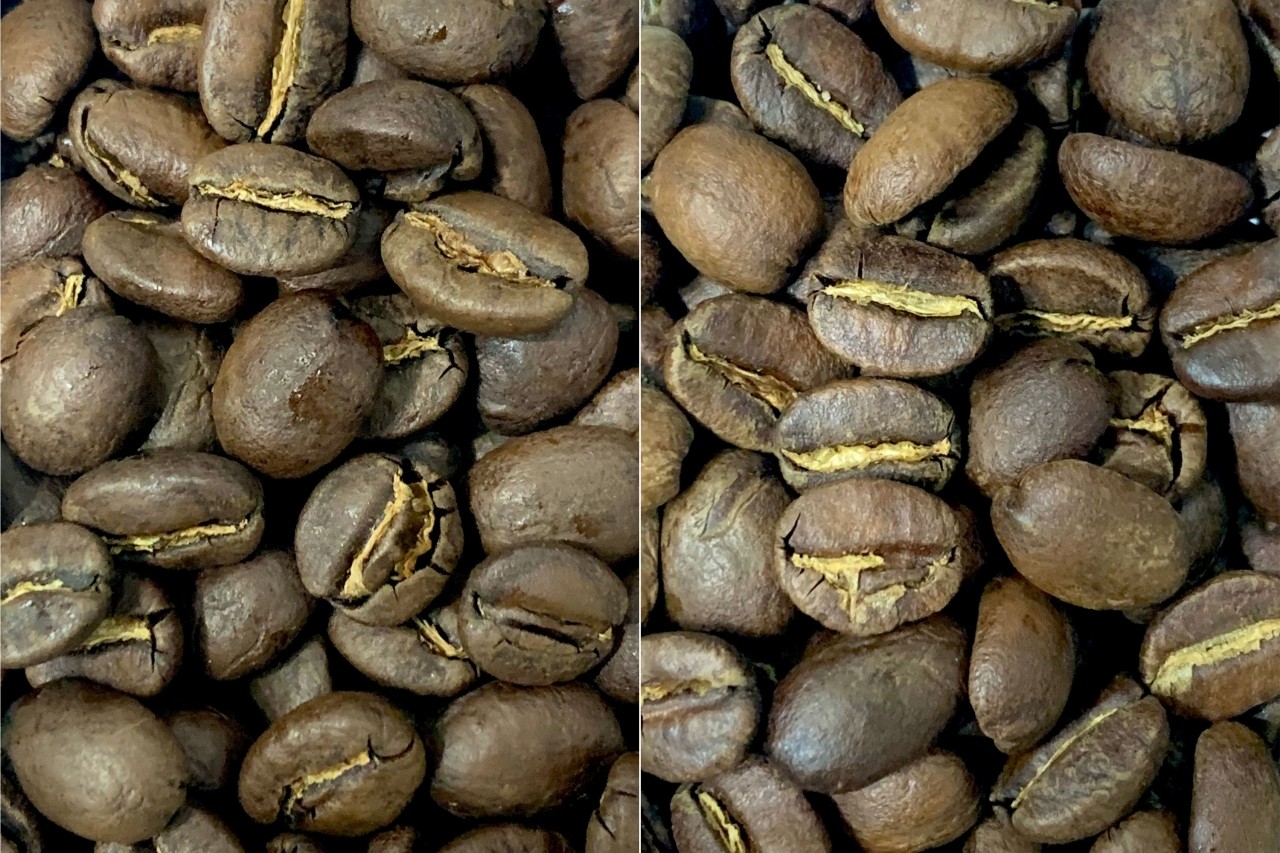
Roasted by Yoshiyuki Nakamura mamepolepole (left), and Tomomichi Morifuji of RED POISON COFFEE ROASTERS (right)
On the left, `` mamepolepole Yoshiyuki Nakamura '' roasts the coffee to a ``medium roast.''
On the right, RED POISON COFFEE ROASERS Tomomichi Morifuji roasts cinnamon roast.
It's hard to tell from the Shin , but you can see that the beans roasted by mamepolepole Nakamura are a little more puffy and have a little bit of oil floating on top.
The aroma when you open the bag tells a clear difference, so I'm looking forward to trying it right away.
On the left, `` mamepolepole Yoshiyuki Nakamura '' roasts the coffee to a ``medium roast.''
On the right, RED POISON COFFEE ROASERS Tomomichi Morifuji roasts cinnamon roast.
It's hard to tell from the Shin , but you can see that the beans roasted by mamepolepole Nakamura are a little more puffy and have a little bit of oil floating on top.
The aroma when you open the bag tells a clear difference, so I'm looking forward to trying it right away.
Roasted by Yoshiyuki Nakamura mamepolepole

First, I would like to try SL28 , roasted by mamepolepole Yoshiyuki Nakamura .
It will be the same every time, but I will use a Melita dripper with paper drip and extract 140ml of coffee from 14g of coarsely ground coffee beans.
It will be the same every time, but I will use a Melita dripper with paper drip and extract 140ml of coffee from 14g of coarsely ground coffee beans.
This is a brewing method that I find very useful as it allows me to extract a good balance from any roasted bean.
This time, I'll be pouring using Kalita's Wave pot so I can pour a slightly thicker pour.
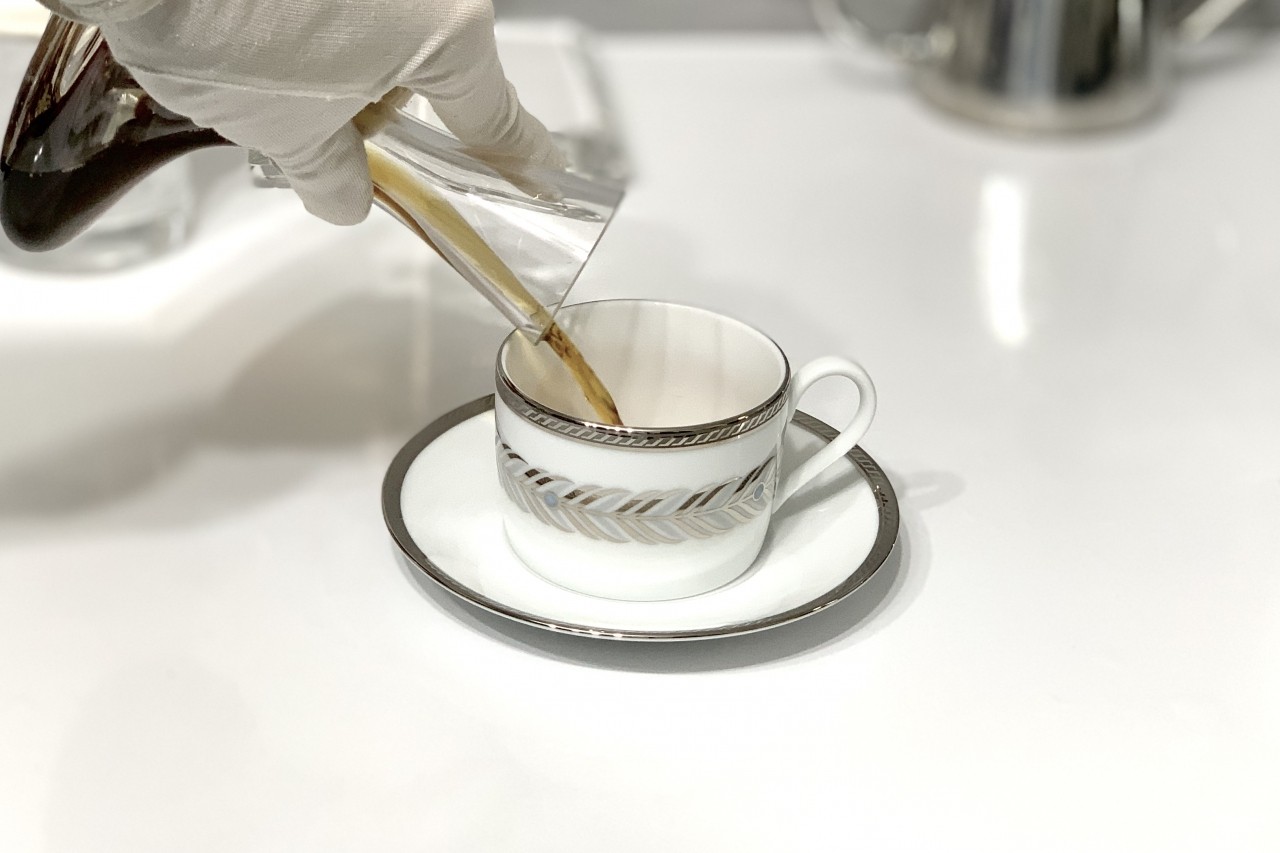
When tasting, use a cup with a slightly thicker mouth so that you can easily experience the rounded texture.
Well then, let's eat.
It has a refreshing green aroma like green tea and a sour taste reminiscent of citrus fruits like lime.
Yet the overall tone is mild, and it has a good balance with fragrant notes of cocoa and roasted almonds.
When lightly roasted, many Kenyan beans tend to have a Shin , acidic flavor, which can be a matter of personal preference.
However, this medium roast, Nakamura 's SL28 , does not have the bright tone that gives off a lively acidity, but rather has a milder tone that is often associated with coffee, with a very pleasant acidity that gives off a sense of moderate freshness and breadth of flavor.
However, the bitterness is not sharp, but rather soft and pleasant, stimulating your mouth just enough.
As it cooled, the impression of cocoa remained, but it took on a flavor more similar to herbs such as thyme and even black currant, rather than green tea.
The acidity did not become stronger even after it cooled down, making it easy to drink from start to finish, and it was a very delicious coffee with the distinctive Kenyan aroma and flavor.
Well then, let's eat.
It has a refreshing green aroma like green tea and a sour taste reminiscent of citrus fruits like lime.
Yet the overall tone is mild, and it has a good balance with fragrant notes of cocoa and roasted almonds.
When lightly roasted, many Kenyan beans tend to have a Shin , acidic flavor, which can be a matter of personal preference.
However, this medium roast, Nakamura 's SL28 , does not have the bright tone that gives off a lively acidity, but rather has a milder tone that is often associated with coffee, with a very pleasant acidity that gives off a sense of moderate freshness and breadth of flavor.
However, the bitterness is not sharp, but rather soft and pleasant, stimulating your mouth just enough.
As it cooled, the impression of cocoa remained, but it took on a flavor more similar to herbs such as thyme and even black currant, rather than green tea.
The acidity did not become stronger even after it cooled down, making it easy to drink from start to finish, and it was a very delicious coffee with the distinctive Kenyan aroma and flavor.
Roasted by Tomomichi Morifuji at RED POISON COFFEE ROASTERS
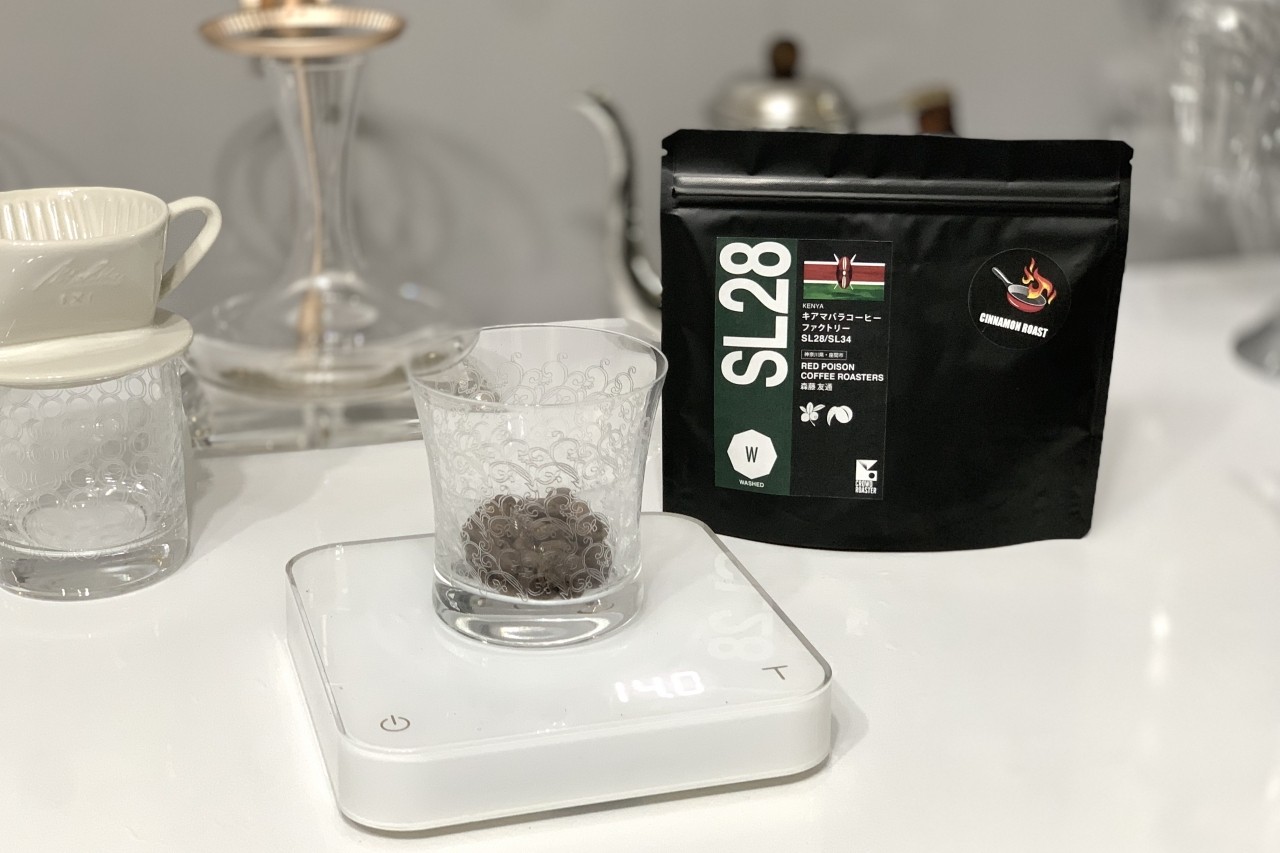
Next up, I would like to try SL28 roasted by Tomomichi Morifuji of RED POISON COFFEE ROASTERS.
The extraction method is the same.
The tasting is done in a wine glass.
The extraction method is the same.
The tasting is done in a wine glass.
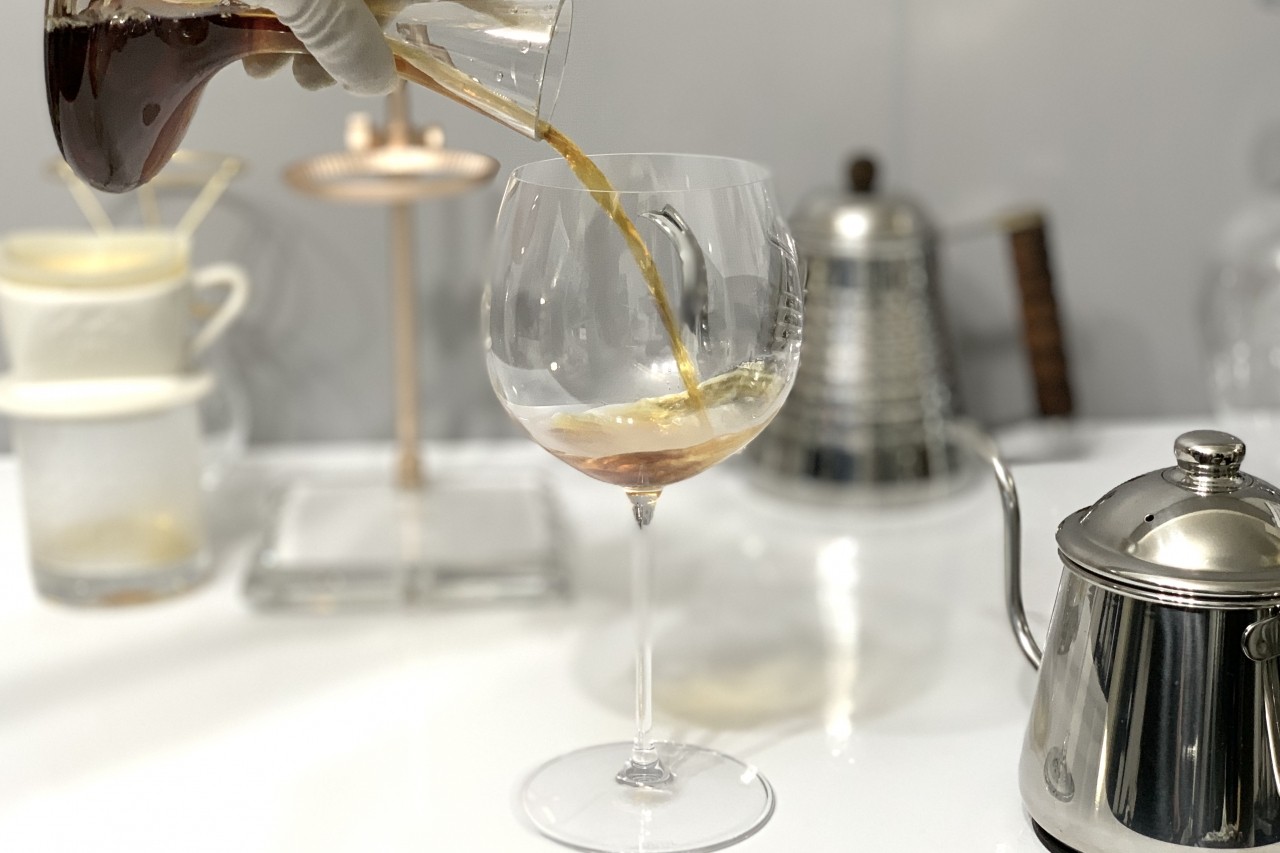
It has a delicate and gentle attack with a juicy acidity reminiscent of bright blood orange.
Gradually you will notice an impression of black currant and a sweetness like candy.
The aftertaste is very sweet.
It really does leave a sweet aftertaste, like after eating starch syrup.
Yet, like real candy, it doesn't leave too much behind.
The sweetness gradually fades away, leaving only a refreshing, pleasant feeling.
As mentioned above, there is a very strong impression of fruits such as orange and black currant, but rather than the sharp acidity that is often avoided, it has a juicy acidity with a rounded tip and a thick acidity.
Gradually you will notice an impression of black currant and a sweetness like candy.
The aftertaste is very sweet.
It really does leave a sweet aftertaste, like after eating starch syrup.
Yet, like real candy, it doesn't leave too much behind.
The sweetness gradually fades away, leaving only a refreshing, pleasant feeling.
As mentioned above, there is a very strong impression of fruits such as orange and black currant, but rather than the sharp acidity that is often avoided, it has a juicy acidity with a rounded tip and a thick acidity.
Perhaps it is the sourness of this texture that stimulates saliva production, resulting in a refreshing aftertaste.
When you put it in your mouth it tastes like fresh fruit, but the aftertaste is like eating a fruit candy, which is very interesting.
As it cooled it took on a slightly apricot-like flavour.
The sweetness impression remains the same.
It seems like the flavor has changed from orange candy to apricot candy.
The sweet impression of this Morifuji roasted [ SL28 ] is different from the sweetness you get from coffee beans that are roasted a little more deeply, and I think the sweetness is due to the fact that it is not roasted very deeply.
Some people may imagine "sweet coffee" to be "deeply roasted coffee with a rich, full-bodied mouthfeel," but the sweetness of light to medium roasts is also very pleasant, and I personally love it.
If you've never had the impression that lightly roasted coffee tasted too sweet, I'd recommend you try this coffee.
It was a delicate yet bright, fruity and very sweet coffee.
After the taste test
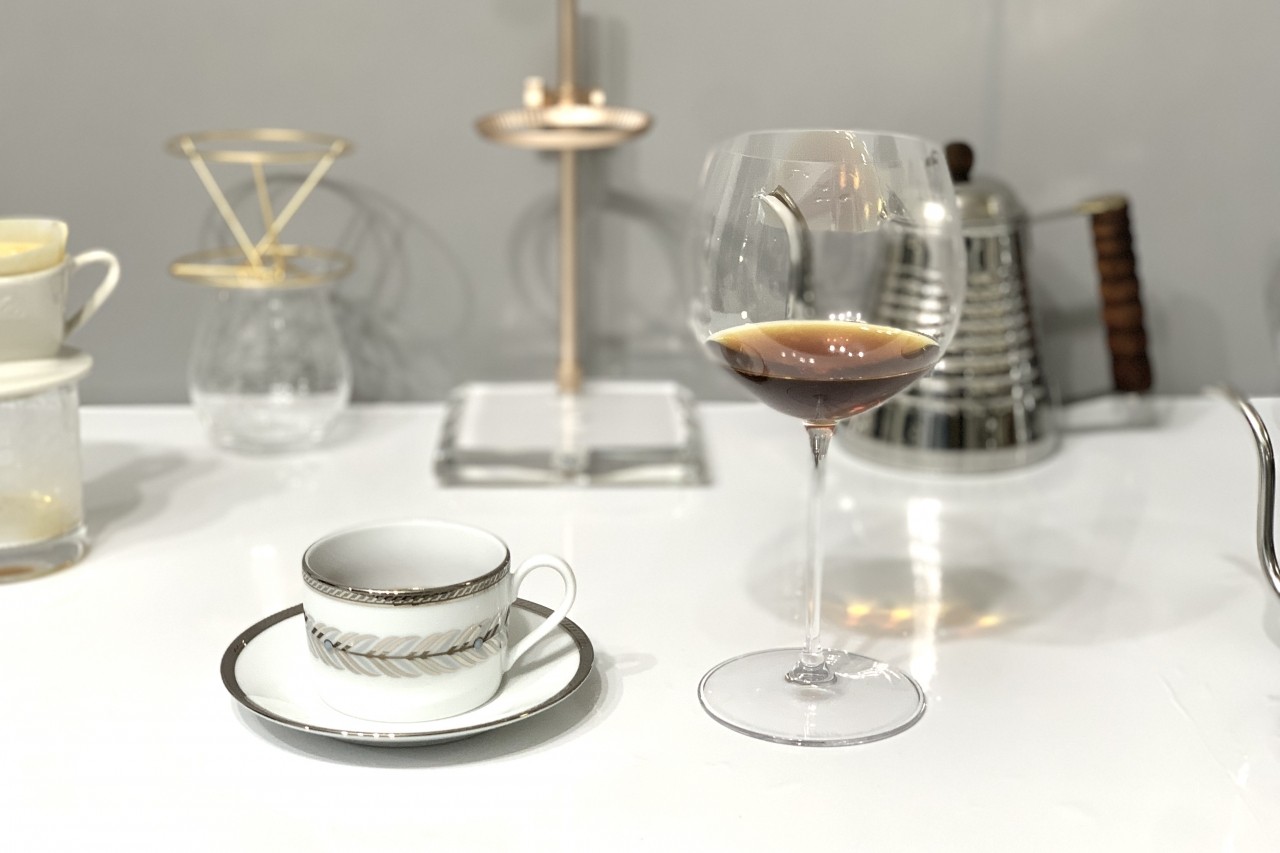
This time, we enjoyed SL28 coffee, roasted to different degrees by two different roasters.
The roasted beans are all different in every respect, apart from the raw beans themselves, in terms of roasting method, roasting environment, roasting degree, and roasting date, but both share a common impression of citrus fruits and black currant.
Also, perhaps due to the way they were finished, neither coffee had the sharp, assertive acidity that many people shy away from; instead, they had a pleasant, well-textured acidity that nicely accentuated the coffee and brought it all together, making them consistently enjoyable from when they were hot to when they were cold.
The roasted beans are all different in every respect, apart from the raw beans themselves, in terms of roasting method, roasting environment, roasting degree, and roasting date, but both share a common impression of citrus fruits and black currant.
Also, perhaps due to the way they were finished, neither coffee had the sharp, assertive acidity that many people shy away from; instead, they had a pleasant, well-textured acidity that nicely accentuated the coffee and brought it all together, making them consistently enjoyable from when they were hot to when they were cold.
The roasting and brewing dates (the date this review was written) of the coffee beans in this article are as follows.
Roasted by mamepolepole Nakamura Roasted on April 1, 2023 Extracted on May 13, 2023 Aging: 42 days Roasted by RED POISON COFFEE ROASTERS Morifuji Roasted on April 29, 2023 Extracted on May 28, 2023 Aging: 29 days
Both were aged for about a month in a cellar that I use for coffee.
Please note that this is only a guide, as the best timing will vary depending on personal preference, the storage environment for the coffee beans, the extraction method, etc.
Again, this review is not a guarantee that you will be able to enjoy the flavor described above, but I hope that it will be of some help to you in your coffee life.
This is a coffee bean that has the potential to produce a variety of flavors depending on the timing and method of extraction, so be sure to try it out and find the flavor that suits you best.
That's all for this time.
I hope that good coffee fills your coffee life.
Roasted by mamepolepole Nakamura Roasted on April 1, 2023 Extracted on May 13, 2023 Aging: 42 days Roasted by RED POISON COFFEE ROASTERS Morifuji Roasted on April 29, 2023 Extracted on May 28, 2023 Aging: 29 days
Both were aged for about a month in a cellar that I use for coffee.
Please note that this is only a guide, as the best timing will vary depending on personal preference, the storage environment for the coffee beans, the extraction method, etc.
Again, this review is not a guarantee that you will be able to enjoy the flavor described above, but I hope that it will be of some help to you in your coffee life.
This is a coffee bean that has the potential to produce a variety of flavors depending on the timing and method of extraction, so be sure to try it out and find the flavor that suits you best.
That's all for this time.
I hope that good coffee fills your coffee life.
2023.05.28
Takeru
Takeru


